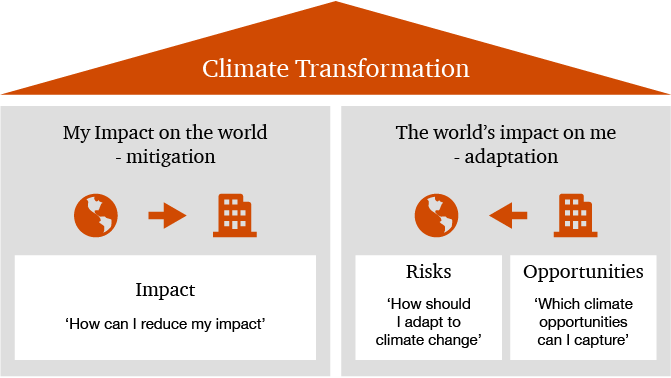
Pressure on ambitious climate goals increases
More and more companies are embracing ambitious climate actions with short-term reduction targets and long-term net zero commitments. What does this entail? And how to start this journey? This is part of two of PwC’s Climate Transformation series, a sequence of five articles about both the impact of climate change on companies and the impact of companies on our changing climate.

Net zero: the pressure is on
Moving to net zero means aligning with the Paris Agreement. Scientific research shows that global temperature increase needs to be limited to 1.5°C above pre-industrial levels, to limit impacts of climate change. But, temperatures are rising, and have already increased by an average of 1.1° compared to the 1800s. In June 2023, the threshold of 1.5C has even been crossed temporarily. To keep global warming limited to 1.5°C, emissions need to be reduced by 45 percent by 2030 and society needs to reach net zero by 2050.
Pressure to do so is coming from all stakeholder groups and drives companies to make net zero pledges. Stakeholders’ expectations on decarbonization are increasing, investors ask questions on emission reduction plans, and rating agents expect updates on efforts and progress.
Both suppliers and customers push companies towards net zero as part of their own supply chain emission reduction ambitions, and may at a certain point discontinue professional collaborations with companies that do not show progress on reducing their emissions. And, not of least importance, regulators increasingly request transparency on decarbonization plans.
Net zero and CSRD - new reporting regulations require action
The reporting regulations of the CSRD add a new layer of pressure to companies in the EU. Large companies in the EU are shortly obliged to disclose their organisational transition plan to climate neutrality.
What does this look like? ESRS E1, the climate change standard under the CSRD, requires companies to disclose emission reduction targets and explain how targets align with limiting global warming to 1.5°C. Specifically, it states that setting a net zero target should lead to value chain emission reduction of 90 to 95 per cent and neutralising any residual emissions by permanently removing an equivalent volume of CO2. This is in line with the Science Based Targets initiative (SBTi), currently the market leading approach for corporates regarding (voluntary) guidelines.
A guide to understanding Net Zero-terminology
When talking about decarbonization, terms such as carbon neutral, climate neutral and net zero are often used interchangeably. However, they do not mean exactly the same. Please find an overview of terms and definitions.
An overview
- What exactly is net zero?
- The Net Zero Standard
- Climate neutral
- Carbon neutral
- Decarbonization in CSRD and ESRS E1
What exactly is net zero?
Net zero is a term that is generally used in organisational contexts. A company reaches net zero when it has reduced its GHG emissions to the furthest extent possible and uses carbon removals to neutralise any potentially remaining emissions. Emissions from throughout a company’s value chain, e.g capital goods, transport, use of sold products, and any financed emissions should be considered here.
The Net Zero Standard
A corporate standard developed by the Science Based Targets initiative (SBTi). To claim Net Zero under SBTi, a company must decarbonize in line with a pathway to limit global temperature rise to 1.5°C. For most organisations this means decarbonization of 90 percent of their own and value chain emissions and removal of remaining emissions by 2050.
The removals need to happen through projects within the supply chain. E.g. buying offsets related to reforestation projects via third parties does not account as carbon removal under the Net Zero Standard.
Climate neutral
The United Nations classify climate neutrality as ‘the idea of achieving net zero greenhouse gas emissions by balancing those emissions so they are equal (or less than) the emissions that get removed through the planet’s natural absorption’. It thus gives more freedom to the balance of emission reduction and removal, and is not directly linked to the corporate context.
Companies that claim carbon neutrality are therefore not bound to reduce emissions to a set extent. They often offset emissions with third party offsets, for example related to clean cooking stove emission reduction projects. There is no strict definition of what offset types can be used to claim climate neutrality.
Carbon neutral
A term used by the European Parliament: ‘Carbon neutrality means having a balance between emitting carbon and absorbing carbon from the atmosphere in carbon sinks. Removing carbon dioxide from the atmosphere and then storing it is known as carbon sequestration. In order to achieve net zero emissions, all worldwide greenhouse gas emissions (GHG emissions) will have to be counterbalanced by carbon sequestration’.
A definition which is thus very close to climate neutral, leading to similar corporate emission actions as described before.
Decarbonization in CSRD and ESRS E1
ESRS E1 discusses climate neutrality, but does not define explicitly what it means. It does request companies to disclose whether and which carbon credits are used to reach climate neutrality, thereby implying that they are allowed to do so. The standard clearly sees net zero and climate neutrality as two separate topics, as it states that net zero targets should be reached by reducing 90-95 percent of GHG emissions and neutralising residual GHG emissions via removals in its own operations and value chain.
The journey towards net zero: transformation often required
Most companies want to be net zero by 2040 or 2050. These target years are relatively far in the future because the steps to get to net zero are simply complicated and fraught. As mentioned, own emissions as well as emissions in the value chain must be reduced by at least 90 per cent. The last 10 per cent of emissions must be removed and stored within the value chain.
Reducing both own emissions and emissions in the entire value chain by at least 90 per cent is a huge task. In practice, it means that many companies must consider adjusting their business model, scrutinise their collaboration with suppliers and customers, and redefine their offerings with carbon reduction as the main starting point.


Example: how can a plastic cup factory ever reach net zero?
For a company producing plastic cups, by example, this thus means that the company cannot reach net zero only by moving towards renewable energy in its own offices and factories. It can also not reach net zero by doing that ánd purchasing carbon credits related to planting of trees to neutralise the rest of its (value chain) emissions.
It can however reach net zero by embarking on a transformational journey; purchasing from low-carbon suppliers, making other material choices, ensuring that its products can be reused or recycled at end-of-life, transporting its goods via low-carbon vehicles, and using renewable energy in its own production processes.
To neutralise the remaining emissions it cannot avoid, it may install carbon capture technology in its processes, and store the captured carbon so that it wil not be released into the atmosphere again.
Five-steps approach to getting started
Business model transformation is one of the many elements on the road to net zero. How do you tackle this? A 5-step plan provides guidance and a starting point.
5-step plan
- 1. Emission baselining
- 2. Setting emission reduction targets
- 3. Developing an emission abatement plan
- 4. Strategically transforming the business model
- 5. Annual reporting
1. Emission baselining
To get started on the journey towards net zero, understanding what the emission footprint looks like is key. This can be done by creating an emissions baseline based on the emission categories of the Greenhouse Gas Protocol.
Per emission category, a screening is needed to assess the relevance of the category to the organisation. If so, estimate the volume of emissions per category to create an overview of the relevant categories. For these categories, emission calculations should be improved with organisation-specific data, to create a robust baseline.
2. Setting emission reduction targets
Net zero emission reduction targets should align with the goal of limiting global emissions to 1.5°C as required by ESRS E1. Following the guidance of the Science Based Targets initiative (SBTi) will help translate the emission baseline and net zero ambition into a concrete net zero emission reduction target.
3. Developing an emission abatement plan
Based on the emission baseline and reduction target, the emission sources are clear. Identify emission reduction options within these categories, and assess their emission reduction potential and implementation cost. This can be visualised in a marginal abatement cost curve (MACC), to facilitate decision making.
Ideally the plan should include aspects such as budget and responsibilities per action, as well as a more general view on how to transform the organisation towards net zero. Carbon pricing can help in the organisational transformation, as it integrates climate impact in financial decisions.
4. Strategically transforming the business model
As stated above, to actually reach net zero, business model transformation is often needed. After developing and executing on the emission abatement plan, organisations should thus start to consider whether full organisational transformation might be needed to reach net zero. In this, they should make sure that their climate impact is integrated into every decision they make, which may often mean moving towards circular business models. For many organisations, constant collaboration throughout the value chain, and potentially co-innovation will be necessary to reach net zero.
5. Annual reporting
ESRS E1 requires reporting on emission reduction targets, current emissions, decarbonisation levers and key actions planned, such as adoption of new technologies. Moreover, it demands publishing on how such a plan is funded and to what extent it is embedded in the organisational strategy.
The work that was undertaken in the previous steps, will enable reporting on these requirements.
Transforming to reach the (provisional) net zero end-station
Great! You have made a start to your journey towards net zero. Remember, however, that it is called a journey for a reason. While you may start with the low-hanging fruit when selecting emission reduction options, you may have to go through transformational steps to actually reach net zero later on in your journey.
Get ready to take some exciting steps, and find comfort in the fact that the corporate ecosystem will be moving with you.

Series on climate transformation - Impacts, risks and opportunities
Climate change demands a lot from businesses. The climate expert team within PwC distinguishes two pillars within climate transformation: the impact of the business on the world and the impact of the world on the business.
This series of five articles focuses on both pillars. The first article in our series covers the impact of the world on the business and deals with quantifying climate risks. The remainder of this series focuses on corporate impact on the circular economy, biodiversity and nature. We conclude with a story on climate risk management, turning awareness into opportunity.
Read more on sustainability and climate

Contact us




















